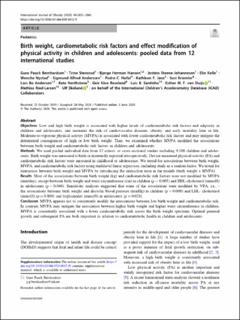Birth weight, cardiometabolic risk factors and effect modification of physical activity in children and adolescents: pooled data from 12 international studies
Bernhardsen, Guro Pauck; Stensrud, Trine; Hansen, Bjørge Hermann; Steene-Johannessen, Jostein; Kolle, Elin; Nystad, Wenche; Anderssen, Sigmund Alfred; Hallal, Pedro C.; Janz, Kathleen F.; Kriemler, Susi; Andersen, Lars Bo; Northstone, Kate; Resaland, Geir Kåre; Sardinha, Luís B.; van Sluijs, Esther M.F.; Ried-Larsen, Mathias; Ekelund, Ulf
Peer reviewed, Journal article
Published version
Permanent lenke
https://hdl.handle.net/11250/3067015Utgivelsesdato
2020Metadata
Vis full innførselSamlinger
- Artikler [5061]
- Publikasjoner fra CRIStin FHI [7536]
Originalversjon
International Journal of Obesity. 2020, 44 (10), 2052-2063. 10.1038/s41366-020-0612-9Sammendrag
Objectives: Low and high birth weight is associated with higher levels of cardiometabolic risk factors and adiposity in children and adolescents, and increases the risk of cardiovascular diseases, obesity, and early mortality later in life. Moderate-to-vigorous physical activity (MVPA) is associated with lower cardiometabolic risk factors and may mitigate the detrimental consequences of high or low birth weight. Thus, we examined whether MVPA modified the associations between birth weight and cardiometabolic risk factors in children and adolescents. Methods: We used pooled individual data from 12 cohort- or cross-sectional studies including 9,100 children and adolescents. Birth weight was measured at birth or maternally reported retrospectively. Device-measured physical activity (PA) and cardiometabolic risk factors were measured in childhood or adolescence. We tested for associations between birth weight, MVPA, and cardiometabolic risk factors using multilevel linear regression, including study as a random factor. We tested for interaction between birth weight and MVPA by introducing the interaction term in the models (birth weight x MVPA). Results: Most of the associations between birth weight (kg) and cardiometabolic risk factors were not modified by MVPA (min/day), except between birth weight and waist circumference (cm) in children (p = 0.005) and HDL-cholesterol (mmol/l) in adolescents (p = 0.040). Sensitivity analyses suggested that some of the associations were modified by VPA, i.e., the associations between birth weight and diastolic blood pressure (mmHg) in children (p = 0.009) and LDL- cholesterol (mmol/l) (p = 0.009) and triglycerides (mmol/l) in adolescents (p = 0.028). Conclusion: MVPA appears not to consistently modify the associations between low birth weight and cardiometabolic risk. In contrast, MVPA may mitigate the association between higher birth weight and higher waist circumference in children. MVPA is consistently associated with a lower cardiometabolic risk across the birth weight spectrum. Optimal prenatal growth and subsequent PA are both important in relation to cardiometabolic health in children and adolescents.
